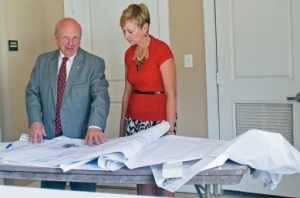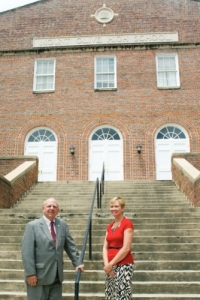School gets new look
By Steve Herring
Published in News on August 4, 2014 1:46 PM

News-Argus/STEVE HERRING
University of Mount Olive President Dr. Philip Kerstetter, left, shows blueprints for the renovations at the Mount Olive Historic Assembly Hall to Rhonda Jessup, director of public relations at the university.

News-Argus/STEVE HERRING
Kerstetter and Mrs. Jessup stand on the steps leading to the former Mount Olive High School auditorium. The university currently uses the building to house students and will move its music department there once renovations are completed.
MOUNT OLIVE -- The former Mount Olive High School is being renovated to house the University of Mount Olive's music program.
The building, known for years as the Mount Olive Historic Assembly Hall, is being revamped at a cost of $750,000.
It already is home to students in the Byrd Apartment Complex and university officials said they saw the opportunity to grow the school's fine arts program by converting the entire building into a home for the music department.
The hall is acoustically sound, said University President Dr. Philip Kerstetter.
"As we got into this whole thing we saw a real opportunity that we might be far better served by moving the whole music program over there," Kerstetter said. "So from a musical experience standpoint, and frankly from a sense of history and a sense of intimacy might be another way of looking at it, that Assembly Hall is just a neat thing."
With that in mind, the university began working on how to best renovate spaces at the Assembly Hall to accommodate the music program. But at the same time, it always the university's intention to keep some residential housing there because of continued growth in the student population.
There is no requirement that music majors live in those apartments, although a lot of them do choose to live there, Kerstetter said.
A few first-floor apartments underneath the auditorium will be sacrificed to make way for six offices, five practice rooms of varying sizes, two classrooms one large and one smaller. The smaller one will double as a computer lab.
One reason the offices will be large is because they will be used for instruction as well, Kerstetter said.
Other rooms include a piano lab, large choral rehearsal room, music library, new restrooms, conference room, updated green room.
"By moving the music program over there we accomplish another thing that we are trying to expand our commitment to the fine arts," Kerstetter said. "First in the terms of what we are doing for music, but then it is going to free up all of that space that music is using adjacent to Laughinghouse in the music suite.
"That then becomes completely vacated and will become available to the art department to say, 'So, how do you want to expand your program? Are you talking about sheer numbers? Are you talking about new academic programs? What are your plans for using that new space?'
"We did a lot of work before we even started moving in there," he said. "We did a lot of painting, put new drapes in, reinforced the stage area to make it completely usable."
By mid-October all of the old wooden seats will be replaced with wider and more comfortable seating.
Kerstetter doesn't expect there to be much more work in the auditorium other than refinishing the old wooden floor to take care of creaks.
"There will be a slightly different configuration of seats, but we end up with about same number," he said.
Kerstetter hopes the first floor will possibly be done by the time students arrive in mid-August -- or at least very early in the fall semester.
The project provides the music department with the space to do what it needs and wants to do, he said. It also ties in with the university's focus on fine arts with the creation of the Fine Arts Circle that is promoting all of the fine arts at the university -- music, visual arts and literary arts creative writing and poetry.
"We are doing a major commitment to the fine arts at the university," Kerstetter said. "I think as this year unfolds you are going to see some pretty interesting things. What we are trying to do is continue the outreach of the Fine Arts Circle."
That includes mailings and encouraging people to check the university's website, www.umo.edu, on a regular basis.
"I want people to see there are a whole bunch of things popping down here," he said.
Kerstetter said he wants to see more collaboration with the Arts Council of Wayne County and Wayne Community College -- something that offers "real opportunities."
There any possibilities of offering events in other communities, he said.
So far the Fine Arts Circle has enjoyed a good membership response out of the Goldsboro area, Kerstetter said.
"We are working to make certain they are coming down and how we can get others down for receptions, meet the artist, or other events," Kerstetter said. "It will take some time, but I think the more people can come down here and have a really good experience and say, 'Wow, I didn't realize and now I am going to come back when I see something coming up.'"
To help bolster interest last year, Kerstetter made the events free.
"That was one of the intentions behind the Fine Arts Circle," he said. "I don't want money to be a thing that prevents somebody from coming to these things.
"So the people in the Fine Arts Circle allow us to underwrite these things and that is a really critical element. That is why I am so grateful for them because they see the value in the fine arts. They see the role that we can play."
For more information about the Fine Arts Circle, contact John Blackwell, vice president for institutional advancement, at jblackwell@ umo.edu.
